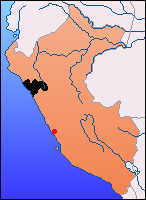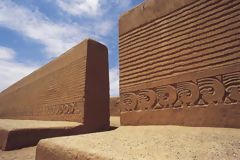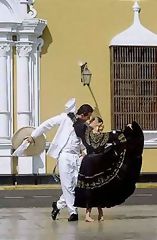 |
Associated pages: |
 The region of La Libertad is one of the oldest sites of human occupation in Peru, with evidence of inhabitants dating back to about 12,000 years ago. This fact is supported by archaeological remains discovered in Pampas de Paiján, La Cumbre, and Quirihua, where stone tools and other artifacts have been found, suggesting the presence of early cultures that adapted to the difficult coastal and mountainous environments. Over the centuries, this region was home to some of the most advanced cultures of ancient Peru.
The region of La Libertad is one of the oldest sites of human occupation in Peru, with evidence of inhabitants dating back to about 12,000 years ago. This fact is supported by archaeological remains discovered in Pampas de Paiján, La Cumbre, and Quirihua, where stone tools and other artifacts have been found, suggesting the presence of early cultures that adapted to the difficult coastal and mountainous environments. Over the centuries, this region was home to some of the most advanced cultures of ancient Peru.
In the coastal region of Chala and the valleys of Yunga, several important cultures developed, including the Cupisnique, Salinar, Virú, and Mochica cultures. Among them, the Mochica culture, also known as Moche, stands out as one of the most remarkable. This civilization, which flourished between the 3rd and 7th centuries AD, left behind an artistic and architectural legacy that continues to amaze archaeologists and scholars. The "huaco retratos," a form of pottery depicting human faces with striking realism, are one of the most well-known examples of Moche artistic talent.
The Mochicas were also notable engineers and architects, building impressive pyramid-shaped temples, such as the Huaca del Sol and the Huaca de la Luna, near Trujillo. These structures not only served as ceremonial centers but also reflect the Mochicas' deep understanding of architecture and environmental control. In these huacas, numerous murals have been discovered depicting scenes of battles, sacrifices, and religious ceremonies, providing invaluable insight into the life and beliefs of this civilization.
In addition to their artistic and architectural skills, the Mochicas developed a complex agricultural system that included irrigation canals, allowing them to cultivate a variety of crops in a region where rainfall was scarce. This knowledge of water management would be passed down to the cultures that followed, such as the Chimú.
 From the 12th century onwards, the region was dominated by the Chimú culture, whose capital, Chan Chan, became the largest adobe city in pre-Columbian America and the second largest in the world of its kind. Chan Chan, which at its peak housed more than 60,000 people, is a marvel of ancient engineering. The city was designed as a series of citadels, each of which was an autonomous complex with plazas, warehouses, work areas, and residences. The walls of the citadels were decorated with intricate reliefs depicting marine animals, fish, and birds, suggesting the Chimú's close relationship with the ocean.
From the 12th century onwards, the region was dominated by the Chimú culture, whose capital, Chan Chan, became the largest adobe city in pre-Columbian America and the second largest in the world of its kind. Chan Chan, which at its peak housed more than 60,000 people, is a marvel of ancient engineering. The city was designed as a series of citadels, each of which was an autonomous complex with plazas, warehouses, work areas, and residences. The walls of the citadels were decorated with intricate reliefs depicting marine animals, fish, and birds, suggesting the Chimú's close relationship with the ocean.
The Chimú were also famous for their skill in gold and silverwork. Their artisans created delicate jewelry and ornaments, many of which have been discovered in tombs and ceremonial sites. The sophistication of their metalwork is further proof of the advanced culture of the Chimú. Additionally, they developed highly efficient agricultural systems, including vast networks of aqueducts and canals to irrigate their lands, allowing them to produce large amounts of food to sustain their growing population.
In the 15th century, the Chimú fiercely resisted the expansion of the Inca Empire but were eventually conquered by Inca Túpac Yupanqui after a prolonged military campaign. Despite their defeat, many of the Chimú's knowledge and techniques were adopted by the Incas, who incorporated them into their vast empire. With the arrival of the Spanish in the 16th century, the region's history changed dramatically.
The city of Trujillo, located near Chan Chan, was founded in 1534 by Spanish conquistadors. Trujillo quickly became one of the main cities of the Viceroyalty of Peru due to its strategic location and access to coastal resources. During the colonial period, the city was an important commercial and agricultural center, and in the 19th century, it played a crucial role in Peru's fight for independence.
Trujillo was the first city in northern Peru to proclaim its independence from Spain on December 29, 1820, marking an important milestone in the country's history. Today, Trujillo is known as the "cultural capital of northern Peru" due to its rich historical heritage and the numerous festivals held there, such as the Marinera Festival in January, a traditional dance competition, and the Spring Festival in September, featuring colorful parades and cultural activities.
In addition to its cultural importance, Trujillo is also the gateway for tourists wishing to explore the archaeological wonders of Chan Chan and the Mochica huacas. With its combination of history, art, and living traditions, La Libertad remains one of the most fascinating and culturally rich regions of Peru.